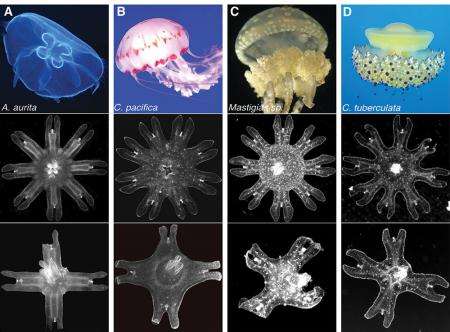June 16, 2015 report
Moon jelly found able to rearrange remaining arms after one is lost to restore balance

(Phys.org)—A small team of researchers with members from the U.S. the U.K. and China has found that moon jellyfish are able to physically rearrange the anatomical structure of their remaining arms after a limb is lost. As the team describes in their paper published in Proceedings of the National Academy of Sciences, the rearranging process, which they call symmetrization, is the first ever seen in any animal.
Many animals have been found able to grow new limbs, and others have been found to develop techniques for dealing with a lost limb, wolves for instance (and dogs) eventually learn to get around using just three legs. But until now, no instance of an animal physically rearranging its limbs has been documented in response to limb loss.
As the team describes in their paper, their discovery came about by accident—they were actually studying a different species of jelly, and just happened to be watching what came about over several days after a moon jelly lost one of its limbs. The creature caused its remaining arms to change where they were located on its body so that they would once again be evenly spaced—a necessity, the team points out, for locomotion and food capture.
Further study revealed that is was not just arms that were moved, it was also the hanging pendulum-like mouth structure and some of its muscles. Curious as to how the creature achieved such a feat, the researchers tested its muscles, first by giving several specimens a muscle relaxant before removing a limb, and watching what happened, and then a muscle stimulant. The first made it so the jelly could not rearrange itself and the second caused it to do so much quicker. That the team concluded, meant that the jelly simply pushed its limbs to where it wanted them to go to restore balance. They note also that development of such an ability has likely been crucial to survival of the jelly as losing a limb is a common occurrence and add further that studying such an ability may lead to new kinds of biomaterials that learn to change themselves when damaged, rather than attempt regeneration.
More information: Self-repairing symmetry in jellyfish through mechanically driven reorganization, Michael J. Abrams, DOI: 10.1073/pnas.1502497112
Journal information: Proceedings of the National Academy of Sciences
© 2015 Phys.org


















